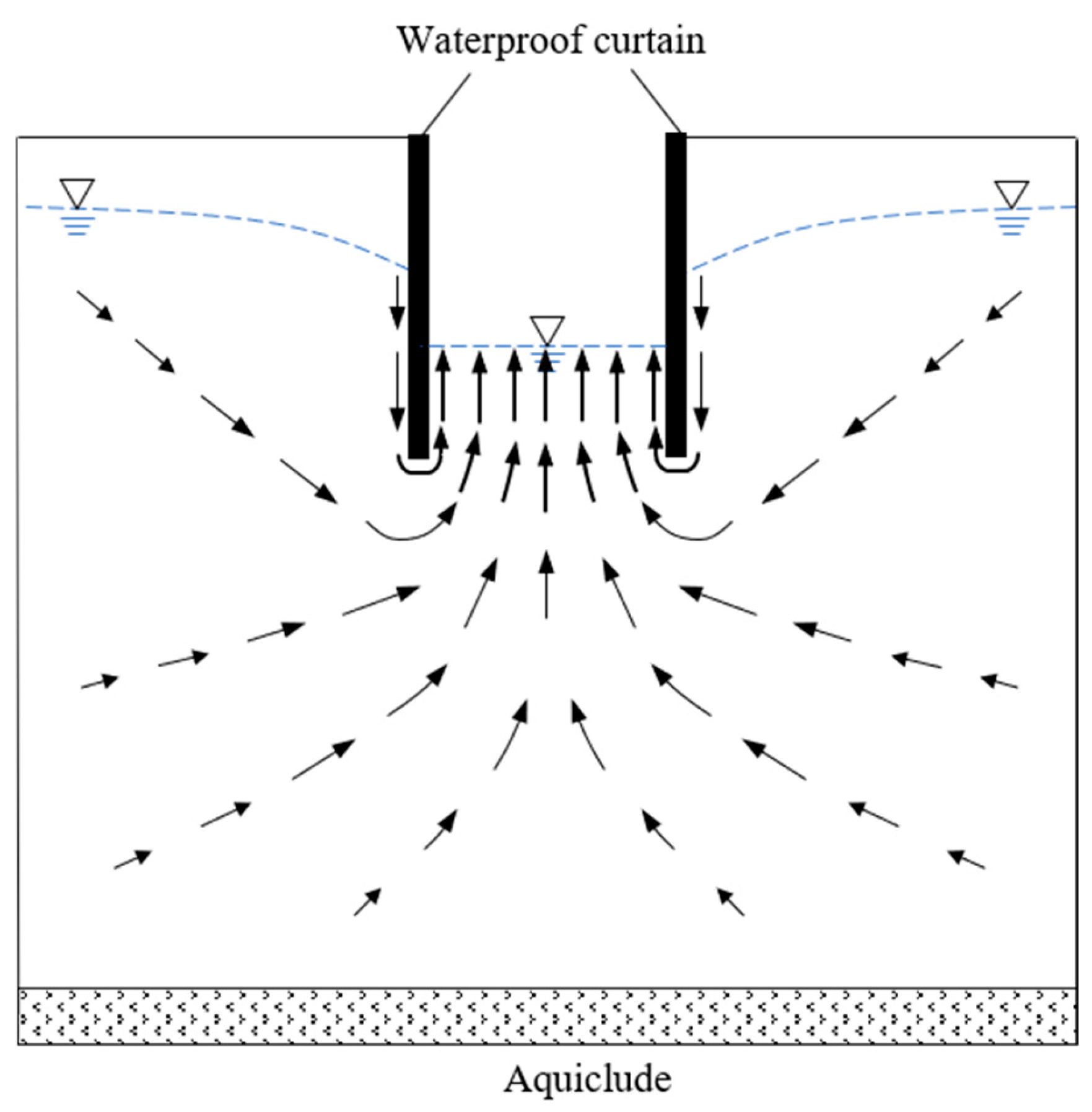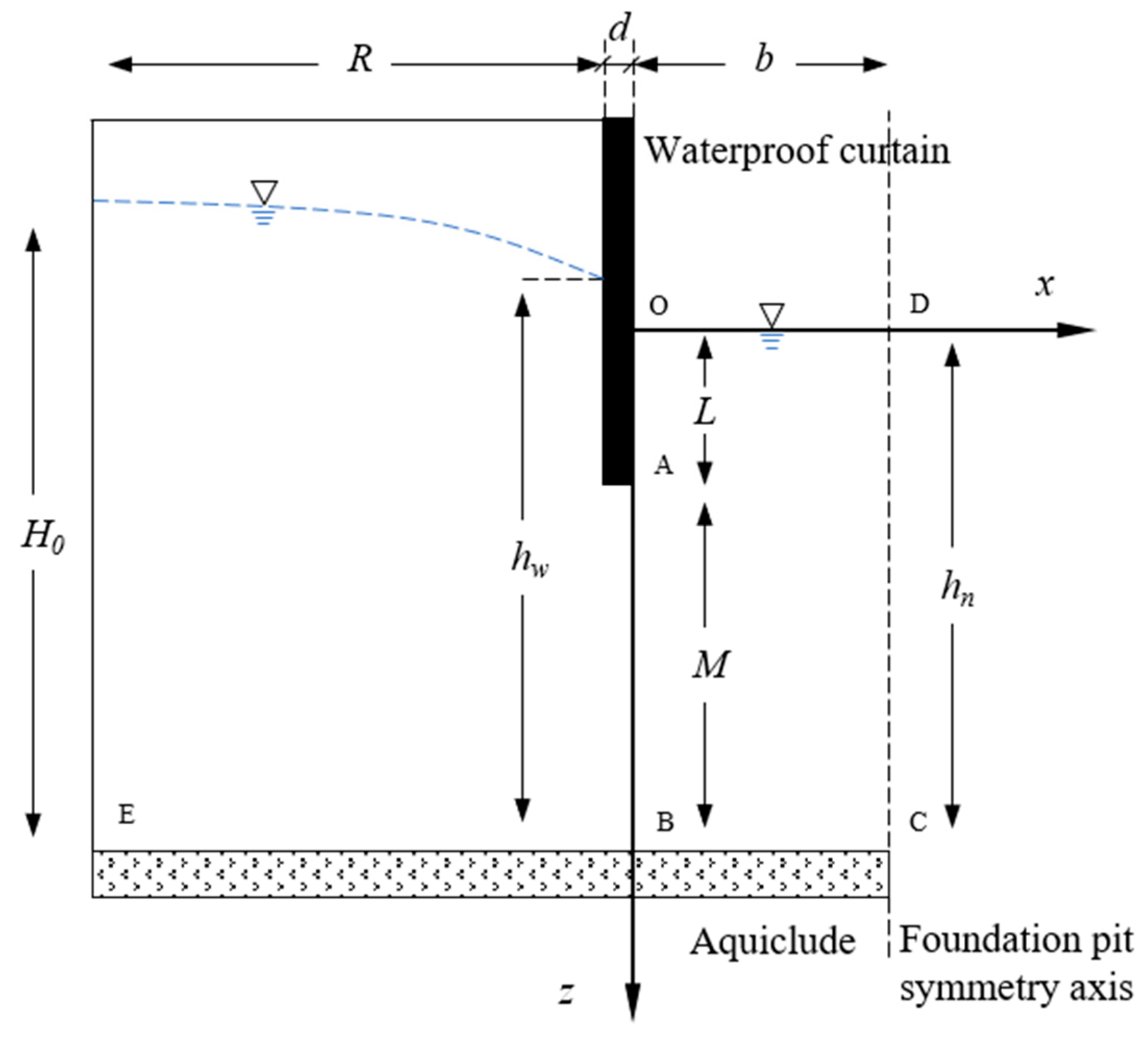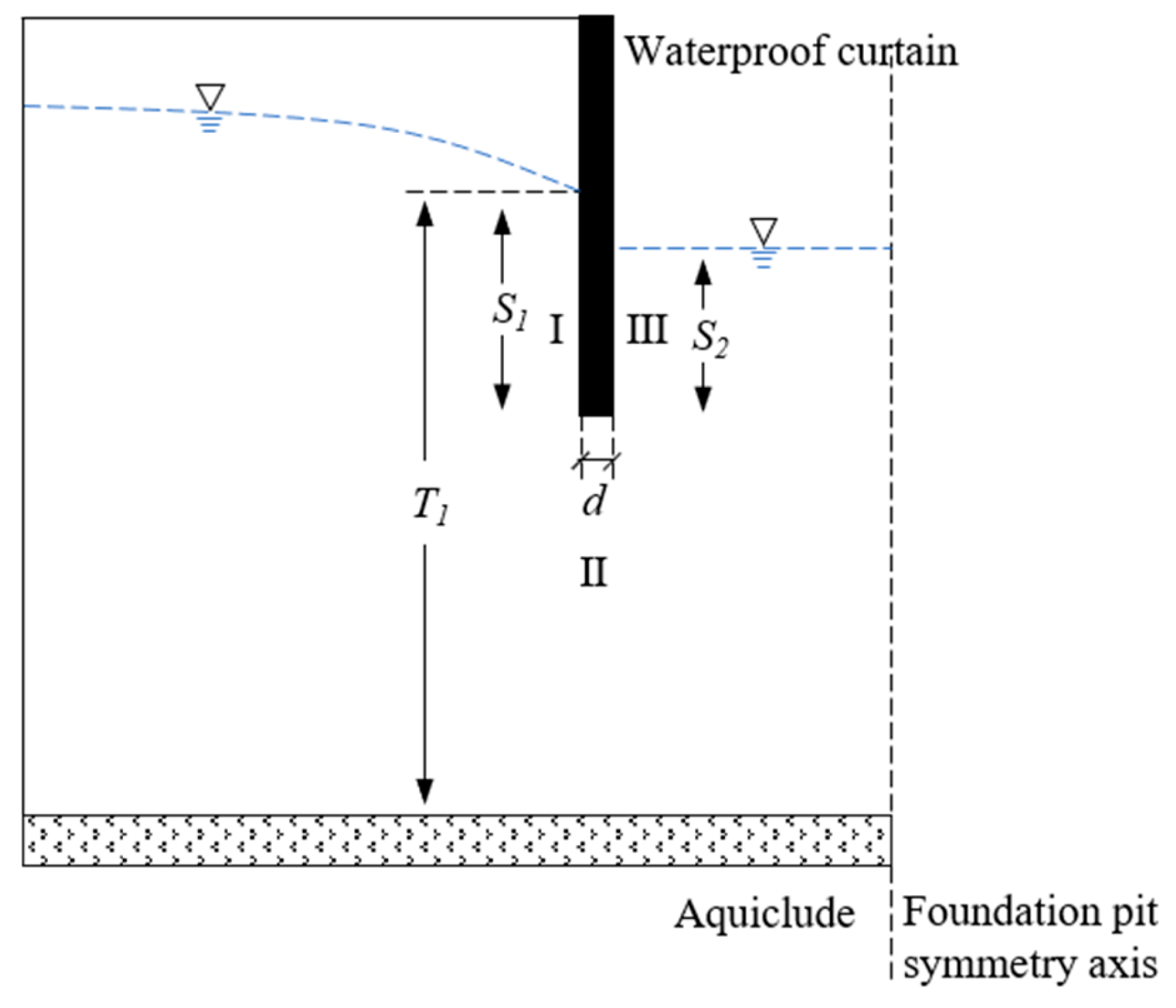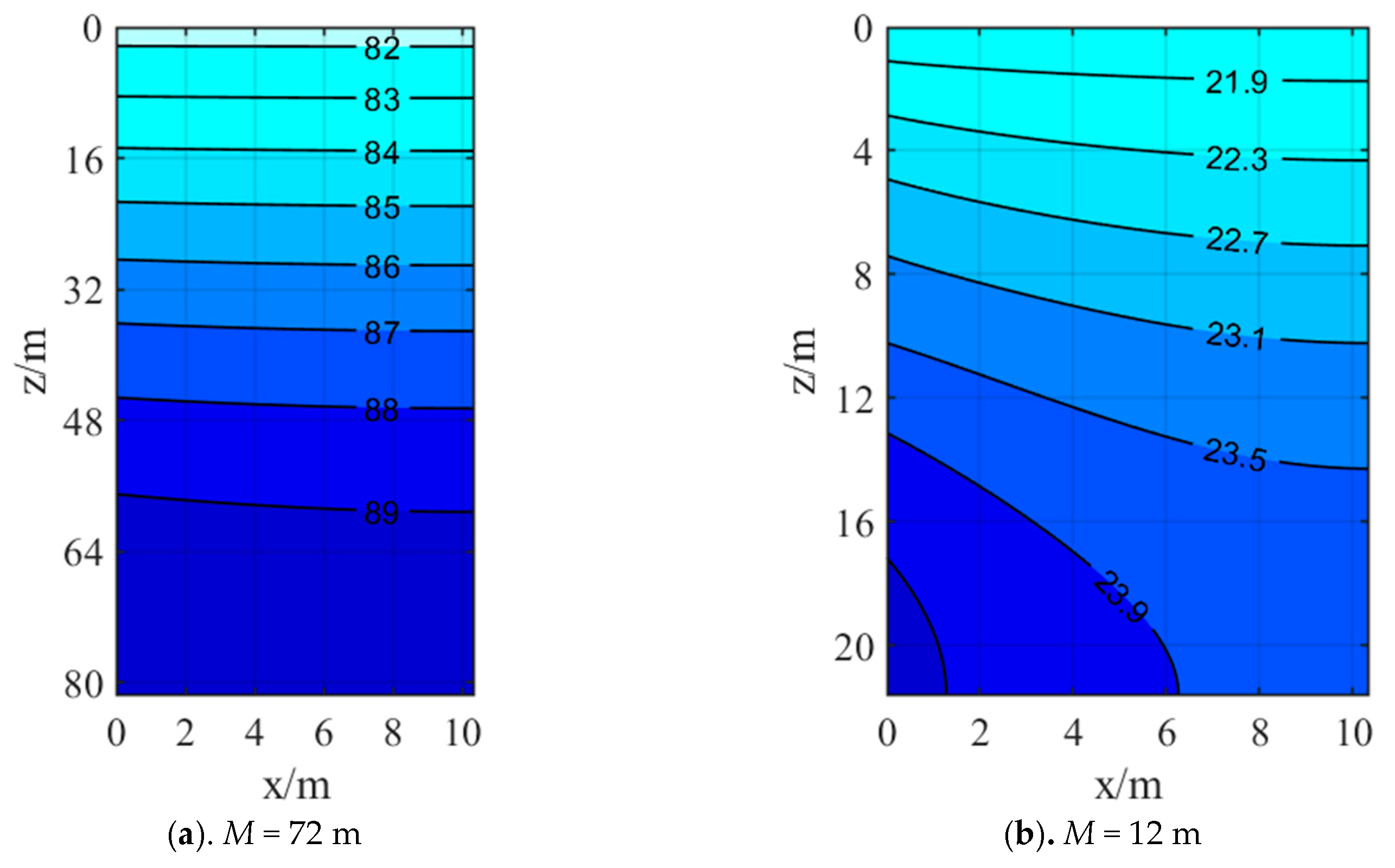Solution of Water Inflow and Water Level Outside the Curtain of Strip Foundation Pit with Suspended Waterproof Curtain in the Phreatic Aquifer
Abstract
:1. Introduction
2. Solution of Foundation Pit Seepage Field
2.1. Establishment and Solution of Theoretical Analysis Model
- The horizontal seepage gradient gradually decreases from the bottom of the foundation pit curtain to the aquiclude.
- The gradient at the top of the aquiclude approaches zero, which is considered here to be zero.
- The integral of the horizontal velocity on the AB section is equal to the water inflow per unit width on the side of the foundation pit, which is recorded as Q, m3/m·d.
2.2. Solution of Foundation Pit Water Inflow
3. Improved Resistance Coefficient Method and Solution of Water Level Outside the Curtain
3.1. Improved Resistance Coefficient Method
3.2. Solution of Water Level Outside the Curtain
4. Engineering Example Verification
4.1. Project Overview
4.2. Comparison of Engineering Measured Data and Calculation Results
5. Conclusions
- Based on the seepage characteristics of a foundation pit with a suspended waterproof curtain in a deep aquifer, it is assumed that the horizontal hydraulic gradient decreases linearly from the bottom of the waterproof curtain to the top of the aquiclude. The seepage field is solved using the separation variable method, and the distribution function of the hydraulic head inside the foundation pit is obtained.
- Based on the distribution function of a hydraulic head inside the foundation pit, the calculation expression of water inflow per unit width of a suspended waterproof curtain strip foundation pit is derived. By using the improved resistance coefficient method, the water level outside the curtain is connected with the solved hydraulic head in the pit and solved.
- The calculation results of the water inflow per unit width of the foundation pit and the water level outside the curtain, as well as the calculation results of the existing model, are compared with the measured data of the project, and the error of the calculation results of this paper is within the acceptable range, which proves the rationality of the solution method provided in this paper.
Author Contributions
Funding
Institutional Review Board Statement
Informed Consent Statement
Data Availability Statement
Acknowledgments
Conflicts of Interest
References
- Liu, K. Study on the Influence of Foundation Pit Deformation Triggered by Water-Rich Strata Precipitation. Master’s Thesis, East China Jiaotong University, Nanchang, China, 2023. [Google Scholar] [CrossRef]
- Du, S.; Liu, P.; Wang, W.; Shi, W.; Li, Q.; Li, J.; Li, J. Numerical Simulation and Analysis of the Influencing Factors of Foundation Pit Dewatering under a Coupled Radial Well and Curtain. Water 2023, 15, 1839. [Google Scholar] [CrossRef]
- Jiang, Y.; Gao, Y.; Yuan, Q.; Li, X.; Sun, K.; Sun, L. Simulation and Risk Assessment of Flood Disaster at the Entrance to a Rail Transit Station under Extreme Weather Conditions—A Case Study of Wanqingsha Station of Guangzhou Line 18. Water 2024, 16, 2024. [Google Scholar] [CrossRef]
- Li, D.; Zhao, Y.; Liu, N.; Jiao, L.; Liu, Z. Evaluation and Analysis of Seepage Stability in the Surrounding Strata of a Dewatering Foundation Pit Based on Differences in Particle Initiation Conditions. Indian Geotech. J. 2024, 1–14. [Google Scholar] [CrossRef]
- Chen, L. On groundwater prevention technology and case analysis. Shanxi Archit. 2021, 47, 59–60+116. [Google Scholar] [CrossRef]
- Xu, Y.; Shen, S.; Ren, D.; Wu, H. Analysis of Factors in Land Subsidence in Shanghai: A View Based on a Strategic Environmental Assessment. Sustainability 2016, 8, 573. [Google Scholar] [CrossRef]
- Yang, T.; Tong, L.; El Naggar, M.H.; Yan, X. Hydraulic head difference at two sides of suspended waterproof curtain during multi-grade dewatering of excavation. Undergr. Space 2023, 10, 137–149. [Google Scholar] [CrossRef]
- Wang, P.; Wu, Y.; Xu, Y. Numerical simulation analysis on settlement control by recharge in deep foundation pit with suspended waterproof curtain. J. Hefei Univ. Technol. Nat. Sci. 2023, 46, 1097–1102. [Google Scholar]
- Yang, K.; Xu, C.; Chi, M.; Wang, P. Analytical Analysis of the Groundwater Drawdown Difference Induced by Foundation Pit Dewatering with a Suspended Waterproof Curtain. Appl. Sci. 2022, 12, 10301. [Google Scholar] [CrossRef]
- Chu, Y.; Shi, J.; Ye, Z.; Liu, D. Dewatering Characteristics and Drawdown Prediction of Suspended Waterproof Curtain Foundation Pit in Soft Soil Areas. Buildings 2024, 14, 119. [Google Scholar] [CrossRef]
- Li, D.; Cheng, S.; Liu, N.; Liu, Z.; Sun, Y. Numerical Simulation Study on the Distribution Characteristics of Precipitation Seepage Field in Water-Rich Ultra-Thick Sand and Gravel Layer. Water 2023, 15, 3720. [Google Scholar] [CrossRef]
- Lin, Z.; Li, Y.; Gui, C.; Liu, J.; Qin, X. Method for steady flow of partially penetrating well in phreatic aquifer under constant flow. Chin. J. Geotech. Eng. 2013, 35, 2290–2297. [Google Scholar]
- Li, Z.; Zong, Y.; Wang, B. Influence of Foundation Pit Dewatering and Excavation on Deformation of Support Structure. Site Invest. Sci. Technol. 2023, 6, 19–24+42. [Google Scholar]
- Xiong, H.; Wu, J.; Cai, G. Study on deformation characteristics of deep excavation with suspended curtain in Yangtze River floodplain. J. Beijing Jiaotong Univ. 2023, 47, 130–137. [Google Scholar]
- Shi, J.; Wu, B.; Liu, Y.; Xu, S.; Hou, J.; Wang, Y.; Sun, Q.; Meng, G.; Nong, Z.; Qiu, H.; et al. Analysis of the influence of groundwater seepage on the deformation of deep foundation pit with suspended impervious curtain. Adv. Mech. Eng. 2022, 14, 16878132221085128. [Google Scholar] [CrossRef]
- Wang, X.; Yang, T.; Xu, Y.; Shen, S. Evaluation of optimized depth of waterproof curtain to mitigate negative impacts during dewatering. J. Hydrol. 2019, 577, 123969. [Google Scholar] [CrossRef]
- Wu, Y.; Shen, S.; Lyu, H.; Zhou, A. Analyses of leakage effect of waterproof curtain during excavation dewatering. J. Hydrol. 2020, 583, 124582. [Google Scholar] [CrossRef]
- Wang, X.; Yang, T.; Xu, Y.; Yuan, Y. Laboratory test on the effect of foundation pit dewatering. J. Cent. South Univ. Sci. Technol. 2019, 50, 2823–2830. [Google Scholar]
- Zhang, Q.; Yan, J.; Wang, C.; Zhang, Z. Study on Indoor Model Test of Suspended Water Curtain. J. Northeast. Univ. Nat. Sci. 2020, 41, 1640–1645. [Google Scholar]
- Zhang, B. Study on the Characteristics of Groundwater Seepage Field in Foundation Pit Engineering. Master’s Thesis, China Academy of Building Research, Beijing, China, 2014. [Google Scholar]
- Zhang, B.; Yang, B.; Xue, L.; Liu, F. Experimental study on seepage characteristics of foundation pit with unclosed curtain. Build. Struct. 2022, 52, 2579–2582. [Google Scholar] [CrossRef]
- Luo, Z.; Zhang, Y.; Wu, Y. Finite Element Numerical Simulation of Three-Dimensional Seepage Control for Deep Foundation Pit Dewatering. J. Hydrodyn. 2008, 20, 596–602. [Google Scholar] [CrossRef]
- Wang, K.; Hu, L.; Lv, K. Analysis for Seepage Characteristic of Deep Foundation Pit with Hanging Impervious Purdah. Build. Sci. 2010, 26, 81–84. [Google Scholar] [CrossRef]
- Zhang, Z.; Qin, W.; Zhang, Q.; Guo, Y. Water Control Optimization Method of Foundation Pit with Suspended Waterproof Curtain. J. Northeast. Univ. Nat. Sci. 2021, 42, 242–251. [Google Scholar]
- Yu, J.; Zhang, Y.; Zheng, J.; Zhang, Z. Analytical solution of two-dimensional steady-state seepage field in a pit considering a phreatic surface. Rock Soil Mech. 2023, 44, 3109–3116. [Google Scholar] [CrossRef]
- Shen, S.; Wu, Y.; Misra, A. Calculation of head difference at two sides of a cut-off barrier during excavation dewatering. Comput. Geotech. 2017, 91, 192–202. [Google Scholar] [CrossRef]
- Wang, J.; Tao, L.; Han, X.; Zhou, H. Effect of Suspended Curtain Depth into Stratum on Discharge Rate and Its Optimum Design. J. Beijing Univ. Technol. 2015, 41, 1390–1398. [Google Scholar]
- Bear, J. Dynamics of Fluids in Porous Media; American Elsevier Publishing Company: New York, NY, USA, 1988. [Google Scholar]
- Qin, W. Study on Water Control Method and Optimization of Suspended Water Stop Curtain for Foundation Pit in Water-Rich Stratum. Master’s Thesis, Beijing University of Technology, Beijing, China, 2019. [Google Scholar]
- Mao, C.; Zhou, B. Improved resistance coefficient method for seepage calculation of dam foundation. J. Hydraul. Eng. 1980, 5, 51–59. [Google Scholar]
- Yan, R.; Li, Z.; Huang, Q. Discussion on Several Problems in Foundation Pit Dewatering with Suspended Waterproof Curtain. In Proceedings of the 2004 Shanghai Annual Conference on Soil Mechanics and Geotechnical Engineering, Shanghai, China, 1 November 2004. [Google Scholar]
- Ministry of Housing and Urban-Rural Development of the People’s Republic of China. Technical Specification for Retaining and Protection of Building Foundation Excavations (JGJ 120-2012); China Architecture and Building Press: Beijing, China, 2012. [Google Scholar]





| Dewatering Well Number | Water Inflow/m3/h | Dewatering Well Number | Water Inflow/m3/h |
|---|---|---|---|
| D1 | 67.8 | D73 | 49.7 |
| D2 | 40.7 | D74 | 48.6 |
| D3 | 36.2 | D75 | 31.7 |
| D4 | 63.3 | D76 | 63.0 |
| D5 | 36.3 | D77 | 30.9 |
| D6 | 72.3 | D78 | 49.5 |
| D7 | 85.9 | D79 | 49.0 |
| Parameters | Value |
|---|---|
| Aquifer thickness H0/m | 90 |
| Water level in foundation pit hn/m | 81.62 |
| Stratum permeability coefficient K/m/d | 60 |
| Foundation pit width 2b/m | 20.7 |
| Water entry depth of a waterproof curtain in the pit L/m | 9.62 |
| Flow cross-section thickness M/m | 72 |
| Waterproof curtain width D/m | 1 |
| Calculated Parameters | Measure Value | Calculated Value of This Study | Calculated Value of Wang Junhui’s Formula |
|---|---|---|---|
| Water inflow per unit width Q/m3/m·d | 78.44 | 90.55 | 34.70 |
| water level outside the curtain hw/m | 85.92 | 83.98 | 82.99 |
Disclaimer/Publisher’s Note: The statements, opinions and data contained in all publications are solely those of the individual author(s) and contributor(s) and not of MDPI and/or the editor(s). MDPI and/or the editor(s) disclaim responsibility for any injury to people or property resulting from any ideas, methods, instructions or products referred to in the content. |
© 2024 by the authors. Licensee MDPI, Basel, Switzerland. This article is an open access article distributed under the terms and conditions of the Creative Commons Attribution (CC BY) license (https://creativecommons.org/licenses/by/4.0/).
Share and Cite
Li, D.; Liu, N.; Han, J.; Shen, J. Solution of Water Inflow and Water Level Outside the Curtain of Strip Foundation Pit with Suspended Waterproof Curtain in the Phreatic Aquifer. Appl. Sci. 2024, 14, 7918. https://doi.org/10.3390/app14177918
Li D, Liu N, Han J, Shen J. Solution of Water Inflow and Water Level Outside the Curtain of Strip Foundation Pit with Suspended Waterproof Curtain in the Phreatic Aquifer. Applied Sciences. 2024; 14(17):7918. https://doi.org/10.3390/app14177918
Chicago/Turabian StyleLi, Da, Ningyi Liu, Jiahe Han, and Junhong Shen. 2024. "Solution of Water Inflow and Water Level Outside the Curtain of Strip Foundation Pit with Suspended Waterproof Curtain in the Phreatic Aquifer" Applied Sciences 14, no. 17: 7918. https://doi.org/10.3390/app14177918





